Place setting at Hillwood
Since taking up photography, I have tried to see as much of the art as practicable. Most recently, I visited Hillwood in Washington, D.C., the primary estate of the late Marjorie Merriweather Post, turned into a museum for her tasteful collection of expensive objects, and saw a collection of prints by Alfred Eisenstaedt on special exhibit. The examples are educational. They are as inspiring as they are daunting.
What is most impressive to me, old enough to have grown up shooting film and having come back to it, is the technical skill on display but easy to overlook. Professionals such as Eisenstaedt were using manual cameras, without the metering and the autofocus we take for granted nowadays even on film never mind digital, and they often were working in natural light. Even those who are proficient and prolific likely cannot match those who used full manual controls, day in day out. As important to observe is that some of the images are not perfect, because they were spontaneous rather than staged. A bit of blurriness, however, does not prevent the composition from communicating in the most compelling manner. There are limits to sharpness, and limits to how much it matters.
Post was famous and glamorous, a teetotaler who hosted lavish parties featuring square dancing. She was the heir to the Post cereal fortune (originally Postum), which she expanded into the General Foods conglomerate with acquisition of brands such as Jell-O, Hellman’s, Bird’s Eye, Maxwell House, etc. She increased her wealth further through marriage to, among others, financier Edward Francis Hutton (number two of four husbands), the founder of the eponymous firm with the memorable motto (“when E.F. Hutton talks, people listen,” rated among the best advertising slogans ever, but forgotten since scandal closed the brokerage a generation ago). A major philanthropist, she shuttled among residences with a staff of dozens, including Mar-A-Lago in Palm Beach. Hillwood is chock full of antiquities from Faberge eggs to Post’s personal wardrobe. There is much to be photographed if you like the finer things in life.
Eisenstaedt — “Eisie” to friends — was born in Tczew, Poland (called Dirschau at the time, controlled by Prussian Germany). His career started with a commission to cover the Nobel Prize ceremonies in Stockholm in 1929. From there he proceeded to make his home in America, hired by publisher Henry Luce as one of the original staffers for LIFE magazine — during its run, the leading periodical for photojournalism — and he went to the office daily until his death in 1995. For a sense of how early Eisenstaedt was in the history of photography, he was among the champions of the 35mm format who established it as the standard (versus the medium format press camera with attached flash). He liked its compact size.
His iconic picture is the sailor kissing the nurse on V-J Day in Times Square, New York, celebrating the end of World War II. Their faces are both obscured. (They were identified much later as George Mendonsa and Greta Zimmer Friedman, actually a dental assistant. Recently critics inspired by #MeToo have pointed out the intimacy was not consensual.) The iceskating waiter in upscale St. Moritz is another masterpiece. He also documented Hiroshima after the atomic bomb was dropped on the Japanese city. Aficionados may recognize the snapshot showing the gear of colleague Margaret Bourke-White, a layout of “everyday carry” that would be the envy of any modern enthusiast.
Post and Eisenstaedt met, the “Mid-Century Master” exhibit informed me, when she was the subject of an eighteen-page profile in LIFE, and he followed her around her properties. They developed a friendship. He sent her prints of Scampi, her dog, and also her private jet. The article presented Post as “generous” and “gracious.” For those like me curious, Eisenstaedt relied on a Leica IIIa. In 2013, the specific rangefinder from the kiss photo sold at auction for just shy of $150,000. It came with the 50mm f/2 Summitar lens and VIOOH viewfinder.
Contemporary devices, smart as they are, cannot do what Eisenstaedt was able to do, perceive the world as an original. We fail to appreciate how much help we enjoy, with computations performed automatically on inputs from accelerometers, gyroscopes, and magnetometers. Yet we can aspire and dedicate ourselves to the training that will improve our own vision. To imitate Eisenstaedt is about technique more than technology. For the “kiss” photo, he was wandering through the crowd, looking for opportunities to record the shared rejoicing, and he spotted the man approaching various women. For the iceskating waiter, he prefocused on the chair that the fellow whizzed by. We can copy dedication and diligence. Those traits are intrinsically worthwhile for all endeavors.
My day job is as a teacher. I have realized to be competent, I also must continue to be a student. As a photographer, I am merely an amateur like many. All of us who fancy we might be called “photographer” benefit by seeing how someone such as Eisenstaedt was able to capture a moment in space, details in context, to impart information and transmit feelings. He was a photographer’s photographer.
Note: The Eisenstaedt exhibit at Hillwood runs through January 2020.
Share this post:









Comments
Scott Edwards on Studying Eisenstaedt – By Frank Wu
Comment posted: 13/11/2019
Bruno Chalifour on Studying Eisenstaedt – By Frank Wu
Comment posted: 13/11/2019
bwf on Studying Eisenstaedt – By Frank Wu
Comment posted: 14/11/2019
Sciolist on Studying Eisenstaedt – By Frank Wu
Comment posted: 15/11/2019
Guy Webster has made many millions over his career. The youtube couple erm… with respect, do not appear to be multi-millionaires yet.
I wonder if there's something to getting the 'thought/shot' ratio in some kind of balance.